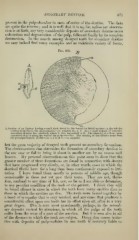Page 861 - My FlipBook
P. 861
SECONDARY DENTINE. 871
present in the pulp-chamber in cases of caries of the dentine. The facts
are quite the reverse ; and it is well that it is so, for, unless my observa-
tion is at fault, any very considerable deposits of secondary dentine mean
exhaustion and degeneration of the pulp, followed finally by its complete
destruction. In the search among decayed teeth for secondary dentine
we may indeed find many examples and an indefinite variety of forms,
3
Fig. 466.
-4, Section of an Incisor having a small dark decay in the buccal (or labial) surface: a, the tubules
leading from this to the pulp-chamber are pointed Out at 6. At c a small deposit of irregular
secondary dentine has occurred, Avhieh is seen magnitied in B. The shading; at e shows some
secondary deposit along the wall of the pulp-chamber. The turning of the tubules away from
the principal deposit, as shown at a, a in B, is very singular.
but the great majority of decayed teeth present no secondary formations.
The circumstances that determine the formation of secondary dentine in
the one case or fail to bring it about in another are by no means well
known. My personal observations on this point seem to show that the
greater number of these formations are found in connection with decays
that have progressed very slowly, or, in other words, cases in which the
dentinal fibrils have for a long time been continuously exposed to irri-
tation. I have found them mostly in persons of middle age, though
occasionally in those not yet past their teens. They are not, there-
fore, confined to any time of life, nor, so far as I am able to determine,
to any peculiar condftion of the teeth or the patient. I think they will
be found oftener in cases in which the teeth have many cavities than in
those in which the cavities are few. The teeth seem bound together by
a bond of sympathy that is very marked, and any cause that produces a
considerable effect upon one tooth has its effect upon all, often in a very
great degree. This is seen most prominently, perhaps, in the second-
ary deposits excited by abrasions, in which all the pulps of the teeth
suffer from the wear of a part of the number. But it is seen also in all
of the diseases to which the teeth are subject. Decay that causes irrita-
tion with deposits of pulp-nodules in one tooth is certainly liable to


